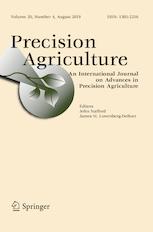Ver ítem
- xmlui.general.dspace_homeCentros Regionales y EEAsCentro Regional CórdobaEEA ManfrediArtículos científicosxmlui.ArtifactBrowser.ItemViewer.trail
- Inicio
- Centros Regionales y EEAs
- Centro Regional Córdoba
- EEA Manfredi
- Artículos científicos
- Ver ítem
Regional model for nitrogen fertilization of site-specific rainfed corn in haplustolls of the central Pampas, Argentina
Resumen
In semi-arid regions, soil water and nitrogen (N) are generally limiting factors for corn (Zea mays L.) production; hence, implementation of appropriate N fertilization strategies is needed. The use of precision agriculture practices based on specific site and crop properties may contribute to a better allocation of fertilizer among management zones (MZ). The aim of this study was to develop a model for diagnosis of N availability and recommendation of N
[ver mas...]
In semi-arid regions, soil water and nitrogen (N) are generally limiting factors for corn (Zea mays L.) production; hence, implementation of appropriate N fertilization strategies is needed. The use of precision agriculture practices based on specific site and crop properties may contribute to a better allocation of fertilizer among management zones (MZ). The aim of this study was to develop a model for diagnosis of N availability and recommendation of N fertilizer rates adjusted to MZ for dryland corn crops growing in Haplustolls. The model considered variability between MZ by including site-specific variables [soil available water content at sowing (SAW) and Available Nitrogen (soil available N-NO3 at planting + applied N, Nd)] using spatial statistical analysis. The study was conducted in Córdoba, Argentina in Haplustolls and consisted in four field trials of N fertilizer (range 0–161 kg N ha−1) in each MZ. The MZ were selected based on elevation maps analysis. Grain yields varied between MZ and increased with larger SAW and Nd at sowing. Grain responses to Nd and SAW in any MZ were not different between sites, allowing to fit a regional model whose parameters (Nd, Nd2, SAW, SAW2) contributed significantly (p < 0.001) to yield prediction. Agronomical and economically optimum N rates varied among MZs. However, the spatial variability of optimum N rates among MZs within sites was not enough to recommend variable N fertilizer rates instead of a uniform rate. Variable N fertilizer rates should be recommended only if variability in SAW and soil N among MZ is greater than that found in this work.
[Cerrar]

Autor
Gregoret, María Celeste;
Diaz Zorita, Martin;
Dardanelli, Julio Luis;
Bongiovanni, Rodolfo;
Fuente
Precision Agriculture 12 : 831 (December 2011)
Fecha
2011-12
Editorial
Springer
ISSN
1385-2256
1573-1618
1573-1618
Formato
pdf
Tipo de documento
artículo
Palabras Claves
Derechos de acceso
Restringido
 Excepto donde se diga explicitamente, este item se publica bajo la siguiente descripción: Creative Commons Attribution-NonCommercial-ShareAlike 2.5 Unported (CC BY-NC-SA 2.5)
Excepto donde se diga explicitamente, este item se publica bajo la siguiente descripción: Creative Commons Attribution-NonCommercial-ShareAlike 2.5 Unported (CC BY-NC-SA 2.5)

